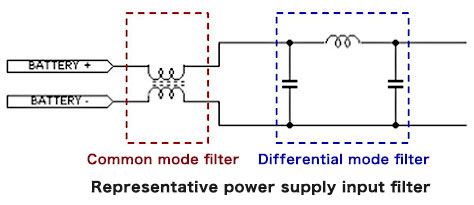A common mode filter is one measure for addressing noise using an inductor. Strictly speaking, the filter is not an inductor, but it is a magnetic component that is vital as a noise countermeasure.
About Common Mode Filters
In a common mode filter, there are two windings on a single core, in a structure that is equivalent to two inductors merged together (see the diagram). When current flows in the windings, magnetic flux is generated in the core, and action in response to a sudden current change makes it difficult for current to flow (choke function). This is the same as the self-induction action of an inductor.

A common mode filter basically acts to pass a differential mode current without passing a common mode current. Here, the fact that two conducting wires are wrapped around one core in the same direction is important.
As shown in the figures below, a differential mode current travels in both directions in the two wires, so that magnetic flux is generated in the core in opposite directions, thereby cancelling out. As a result there is no action impeding the flow of current, which passes through the filter.
On the other hand, a common mode current flows in the same direction, so that magnetic flux is intensified, and consequently current does not flow readily. In other words, a common mode current, which is common mode noise, is not easily passed, and is filtered out.

Dealing with Noise Using Common Mode Filters
The discussion here has mentioned noise in switching power supplies, and so we here present an example of use as an input filter in a power supply.

This diagram was used in “Input Filters for Switching Power Supplies“; a common mode filter is inserted into the input line of a power supply in this way. Compared with a common mode filter for a signal line, a common mode filter having a split-winding construction such that the differential mode impedance is higher is used as the common mode filter for a power supply line. Such components are commonly prepared as common mode filters for power supply lines, and an effect in attenuating differential mode noise can also be expected. However, because the differential mode impedance at frequencies from hundreds of kHz to several MHz is extremely low, in general π-type filters and other filters for differential mode noise are also used.
